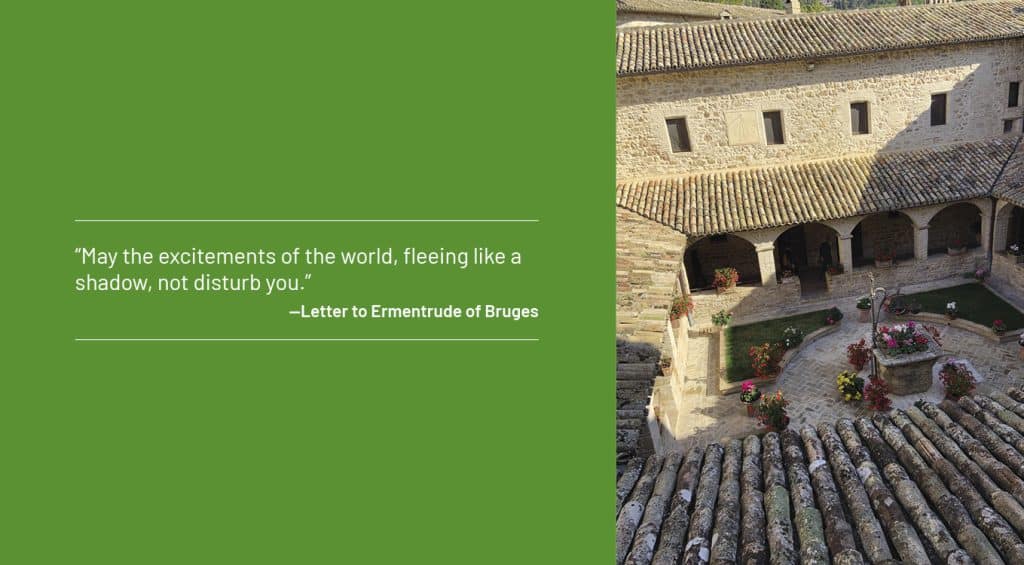Through her writings, St. Clare of Assisi offers us a guide to a stronger faith life.
When I traveled to Assisi for pilgrimage almost 10 years ago, I thought I was going mostly to immerse myself in the life of St. Francis. I knew we would also be learning about St. Clare, his companion, but I didn’t feel as drawn to her. At the time, I knew very little of her story, other than she was connected to St. Francis.
Once I arrived, though, and began to also walk in Clare’s footsteps, I found myself drawn to her. I saw a strong woman who held fast in her beliefs, despite the many challenges she faced along her journey. Her resilience inspired me.
Living tucked away at San Damiano, Clare was able to reach people outside the walls of her monastery and still does to this day. She couldn’t spread her message through traveling and preaching, as Francis and his brothers did. Instead, she did it through her words and everyday examples of humility and simplicity.
During her life, St. Clare wrote a number of things that we can still read today. She wrote four letters to Agnes of Prague, a noblewoman who had come to know of Clare through the friars. Through the letters, Clare counseled Agnes in ways to grow and fully live her faith. Clare also wrote a letter to Ermentrude of Bruges, though whether she actually wrote the letter is disputed. But perhaps her two most important writings were her Testament and the Rule for her order—the first woman to do so. That Rule would turn out to be her final words, being approved just a day before her death.
So perhaps I was drawn to her as a writer, with her use of the written word to evangelize. And while the authorship of some of her letters has been questioned, they still capture the essence of her spirit. Therefore, it only makes sense that I find inspiration in her words. Hopefully, you will too.
“Gaze upon the mirror each day, O Queen and Spouse of Jesus Christ, and continually study your face within it.”
—Fourth Letter to Agnes of Prague
Just as I suspect, most people do, when I look into a mirror, I see my flaws. Unfortunately, given the standards of the society we live in, we have been conditioned to do just that. I focus on the gray hairs that I want to get rid of, the COVID-19 weight I’ve gained but not yet taken off, and the wrinkles I want to cover up. I also use it to help put on the products that I use to mask the things that I find troubling.
What I don’t see reflected back at me, though, is what lies beyond that mirror.
In both her fourth letter to Agnes of Prague and her Testament, Clare uses the mirror as a tool to show others how to live out their faith.
Being born into a family that was part of the majore, or upper class, meant that Clare would have had the finest of things, from clothes to food. So, surely, she had a mirror or two with which to check her appearance. It’s not too difficult to imagine that some of them may have been rather ornate.

In her fourth and final letter to Agnes of Prague, Clare used the concept of a mirror as a tool to help Agnes grow in her faith. Also of nobility, Agnes would have understood the reference. What she might not have realized, though, was the deeper meaning of the mirror of which Clare spoke.
The challenge, Clare told her, was to not only look into the mirror and see ourselves, but to also think of how the mirror is reflecting us to others. She once again used this reference with her sisters in her Testament, saying: “For the Lord himself has placed us not only as a form for others in being an example and mirror, but even for our sisters whom the Lord has called to our way of life as well, that they in turn might be a mirror and example to those living in the world.
“Since the Lord has called us to such great things that those who are to be a mirror and example to others may be reflected in us, we are greatly bound to bless and praise God and be all the more strengthened to do good in the Lord.”
One of Clare’s great gifts was to explain ways to follow our faith in a very accessible way. It is a gift that still guides us today.
“She was the first flower in Francis’ garden, and she shone like a radiant star.”
—St. Bonaventure on Clare
When I am seeking peace, I often go to my garden. I soak in the beauty of the flowers and marvel at how the flowers I planted the year before have continued to grow and spread. Plants that are thriving are often divided and replanted in other places in the yard, where they will once again grow and spread.
I remember having that same feeling I have in my garden when I was in Assisi and looked out over the valley below the city. I would take in the beauty of the wide array of flowers spread across the landscape. And I would marvel at the flowing flower boxes on the houses as I walked throughout the city. It was a feast for the eyes. And it made me think of St. Clare.
Clare often called herself the “little plant of St. Francis.” And while St. Francis may have helped start her growth, she certainly did most of the growing and spreading on her own. Just like the many flowers in Assisi, Clare shared the beauty of her faith for all to see through her actions and words. From inside the walls of San Damiano, she grew and nurtured a community of sisters that flourished and spread far and wide, even to this day. There is great beauty in that.
“May the excitements of the world, fleeing like a shadow, not disturb you.”
—Letter to Ermentrude of Bruges
Every time I read these words, I think of the iconic line from the movie Ferris Bueller’s Day Off: “Life moves pretty fast. If you don’t stop and look around once in a while, you could miss it.” And both quotes are perfectly accurate.
We live in a world of bigger, better, faster. We work longer hours, sleep less, and are constantly on the go. As a result, we find ourselves stressed and exhausted. But in her letter to Ermentrude of Bruges, St. Clare reminds her that it doesn’t have to be that way. And Clare had the example to back up what she was saying.

For most of her life, she lived a very simple and quiet life at San Damiano. She and her sisters found joy and solace in the slow pace of their lives, which were filled with prayer and necessary work. There were no excesses to draw attention away from their focus, which was Christ.
One of the greatest mistakes many of us make is thinking that we will have enough time to do whatever we plan to. We push things off for later or when we have the time. What we don’t think about, though, is, What if there is no later? St. Clare died at a rather young age by today’s standards. But look at how determined she was in her calling and everything she accomplished during those years. With that in mind, we should ask ourselves what we are doing with our time.
“Let the love you have in your hearts be shown outwardly in your deeds.”
—Testament of St. Clare
So many times in life, it seems as if words fall short of what we want to express. Sometimes we just need to show up. One of my most precious memories of my mom, who passed away shortly before I traveled to Assisi, is one of presence.
On the one-year anniversary of a close friend’s passing, her family had a Mass said for her. During a conversation with my mom, I believe I had mentioned it and that I was going but said nothing more. The next morning, though, as I walked into church, I saw my mom sitting in one of the pews. I hadn’t expected anyone to join me. When I walked up and sat next to her, she simply took my hand in hers.
Throughout my life, I’m sure my mom had said thousands of words to me. But one of the things that I most vividly remember is not something that she said, but rather something that she did. She showed up.
St. Clare was known for showing up. She often took care of her sisters—or the friars—who were ill. In fact, she cared for Francis near the end of his life. One story is that Clare used to wash the feet of her sisters after they would come in from doing chores. On this particular day, as she finished washing the feet of one of her fellow sisters, Clare bent over to kiss her foot. Out of humility, the sister pulled her foot back, striking Clare in the mouth. Rather than recoil in pain, Clare simply proceeded to kiss the sister’s foot.
Even when Clare was sick and in bed, she ministered to others as she was able. During those days, she would use the time to sew altar cloths for surrounding churches. Ministry in action—that was Clare’s default. It should be ours as well.
These are only a few lines from St. Clare’s writings that can serve as starting points for the growth of our faith on both the inside and outside. If a simple woman living a life inside the walls of San Damiano can cast such a powerful message and example to the world, imagine what we can do, with the help of her direction.
Who was St. Clare of Assisi? Find out here!

Clare of Assisi Clare of Assisi Clare of Assisi Clare of Assisi Clare of Assisi Clare of Assisi Clare of Assisi Clare of Assisi Clare of Assisi Clare of Assisi xClare of Assisi Clare of Assisi Clare of Assisi Clare of Assisi Clare of Assisi Clare of Assisi Clare of Assisi Clare of Assisi

